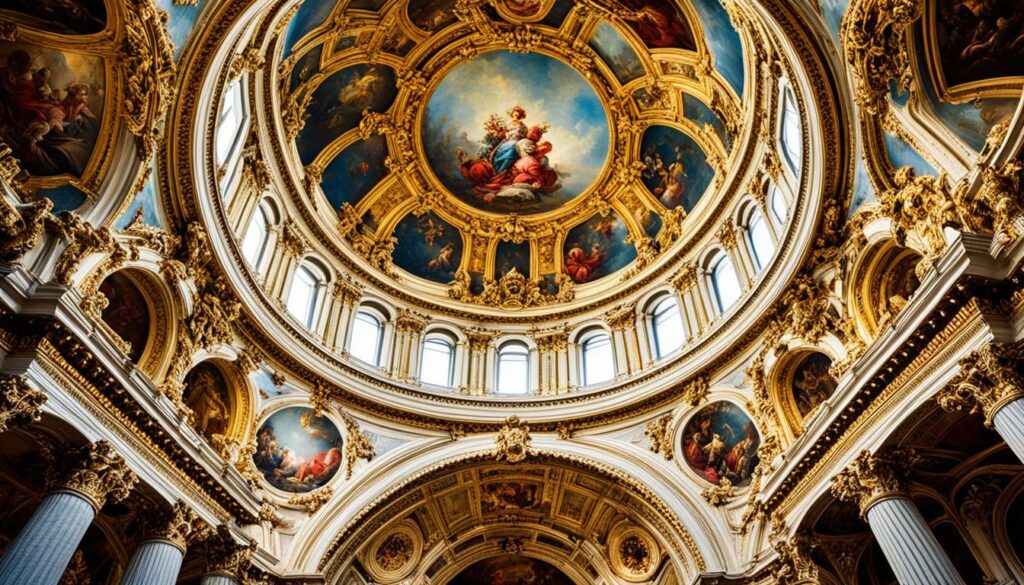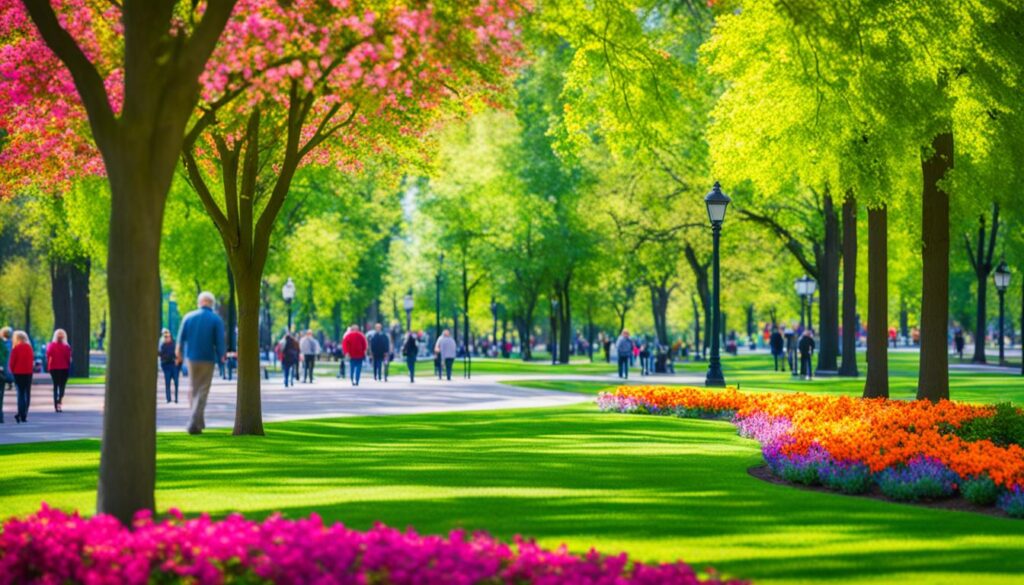The history of art is a fascinating story of human creativity. It takes us from the first cave paintings to today’s modern art. This article invites you on an educational journey through the world of art.
It shows how art has changed over time. From the early days to the modern era, art reflects our cultural and technological growth. You’ll learn about the key art movements, styles, and artists who changed art forever.
Discover the mysteries of ancient cave paintings and the beauty of Greek and Roman sculptures. This article will make you appreciate art more. Join us as we explore the history of art and the human need to create and express ourselves.
Prehistoric Art: The First Artistic Expressions
Art has been around for thousands of years, starting with our prehistoric ancestors. They used art to express themselves. Cave paintings are a key part of this early art. They show us what our ancestors believed and how they lived.
Cave Paintings: A Window into Ancient Life
In places like Lascaux in France and Altamira in Spain, we find amazing cave paintings. These paintings go back to the Paleolithic era. They show the talent and creativity of our ancient friends.
These paintings feature wild animals and symbols of their world. They are a valuable look into early human life.
The Birth of Symbolic Representation
Not only did the cave paintings show animals, but they also had symbols. Symbols like handprints and geometric patterns. These symbols show that our ancestors were expressing more than just what they saw.
They were starting to use art for deeper expression and communication. This shift from simple art to symbolic art is a big step in human creativity.
Studying prehistoric art, especially cave paintings, has given us a lot of insight. These old artworks still amaze and inspire us. They let us peek into the lives and beliefs of our ancient ancestors and the start of symbolic art.
Ancient Art: Civilizations and Their Artistic Legacies
The ancient world was full of amazing art that shaped our culture. Egypt is one of the most famous for its art. It shows us the culture, politics, and beliefs of its time.
Egyptian Art: Pharaohs and Pyramids
Egyptian art is all about the pharaohs and the big pyramids they built. These pyramids were meant to be the final homes for the pharaohs. They show the power and dreams of the ancient Egyptians.
Art in Egypt was very spiritual. The pharaohs were seen as gods. The art had symbols and stories that showed the Egyptians’ love for nature and the afterlife. You can see this in the detailed objects found in pyramids and the big temples by the Nile River.
Classical Art: The Enduring Influence of Greece and Rome
The classical era of ancient Greece and Rome has made a lasting impact on art. Its influence still shapes artistic expression today. Greek sculpture’s perfect forms and Roman architecture’s grandeur have influenced Western art for centuries.
Classical art values balance, symmetry, and the human form. Greek sculptors like Phidias and Praxiteles mastered showing the human body’s beauty and strength. Their work, full of grace and proportion, has become iconic.
Roman architecture also left a big mark on classical art. They built grand structures like the Colosseum and Pantheon. Their designs, including arches and domes, were both practical and beautiful.
Classical art’s impact can be seen in later art movements, like neoclassicism. Today, artists still draw inspiration from ancient Greece and Rome’s beauty and grandeur.
Ancient Greece and Rome’s art has deeply influenced Western art. Their sculptures and architecture inspire artists and art lovers. Their legacy continues to shape art and design.
Medieval Art: Reflecting Religious and Cultural Influences
The medieval era was a time of great artistic growth, influenced by the era’s strong religious and cultural forces. Works like Byzantine art’s stunning mosaics and Gothic architecture’s grand cathedrals show us the beliefs and values of the Middle Ages.
Byzantine and Romanesque Styles
The Byzantine empire, in Constantinople (now Istanbul), was a center of medieval art and culture. Artists there made beautiful mosaics that told stories from the Bible and saints’ lives. These mosaics were more than just pretty pictures; they taught religious lessons.
The Romanesque style, which came later in Western Europe, also focused on the spiritual. It had heavy architecture and symbols in its art.
Gothic Architecture: Soaring Cathedrals
Gothic cathedrals are the symbols of medieval art. They have tall arches, vaults, and spires that show the area’s faith and culture. Building these cathedrals was a big effort by many skilled people.
Medieval art in Europe showed the strong religious and cultural influences of the time. From Byzantine mosaics to Gothic cathedrals, these artworks still move and inspire us. They give us a peek into the beliefs and values of the past.
Renaissance Art: The Rebirth of Artistic Expression
The Renaissance was a time of big changes in art. It brought back creative expression and focused on naturalism and humanism. Artists like the Italian masters led this change, making a lasting impact.
Italian Masters: Leonardo, Michelangelo, and Raphael
Leonardo da Vinci, Michelangelo, and Raphael were key figures in the Italian Renaissance. They showed the power of innovation and curiosity in art. They changed what art could be.
Leonardo da Vinci was known for his deep knowledge of anatomy and science. His paintings, like the Mona Lisa, showed a deep realism. He blended art and science beautifully.
Michelangelo was a genius with the human form. His sculptures, like David and the Sistine Chapel ceiling, amazed people. They showed his incredible skill and vision.
Raphael was known for his beautiful and balanced art. His works, like The School of Athens, showed his skill in capturing the human spirit. He added beauty to Renaissance art.
Together, these artists changed art forever. They started a new era of creativity that still inspires artists and art lovers today.
Baroque Art: Drama and Grandeur
The Baroque era in art was a time of great drama and grandeur. It had a style that amazed both audiences and patrons. This style, popular in the 17th and early 18th centuries, focused on emotion, movement, and intensity.
The Baroque Style: Caravaggio and Bernini
Caravaggio and Gian Lorenzo Bernini were key figures in Baroque art. Caravaggio used chiaroscuro to create intense, immediate paintings. His works, like “Bacchus” and “Medusa,” showed the Baroque’s focus on emotional stories and details.
Bernini was a genius in Baroque sculpture. His sculptures, such as “Apollo and Daphne” and “The Ecstasy of Saint Teresa,” seemed to move. They captured deep spiritual or emotional moments.
Caravaggio and Bernini helped shape the Baroque style. They aimed to bring grandeur, drama, and a sense of power through bold, dynamic art. Their work showed a deep skill in their media.

Enlightenment and the Rise of Academies
The Enlightenment changed how people saw and learned about art. It brought about the start of formal art academies. These places were key in changing the art world. They offered strict training and taught about art theory, techniques, and practices.
The growth of these schools came from the Enlightenment’s big ideas. It valued reason, science, and learning. Art academies aimed to make art more structured, moving past old, more free ways of creating.
The Enlightenment’s focus on learning changed the art scene. Art academies became the main places for learning about art. They helped train the next artists, sculptors, and architects. These schools taught technical skills, critical thinking, and the importance of art history and culture.
Art academies like the Académie Royale de Peinture et de Sculpture in France and the Royal Academy of Arts in England changed art. They helped shape what art was valued and influenced new art movements. They also made art better by refining techniques.
Romanticism: Emotion and Individuality in Art
The Romantic era changed art, moving away from the Enlightenment’s focus on reason. It valued emotion, individuality, and a bond with nature. Artists, especially those in landscape painting, aimed to show nature’s raw beauty and deep feelings.
Romantic Landscape Paintings
Romantic landscape paintings showed artists’ deep feelings and personal views. J.M.W. Turner and John Constable are famous for their stunning views of nature. They aimed to capture the beauty and how it affects us, not just what it looks like.
These paintings often had dramatic skies, rough seas, and wild landscapes. They showed nature’s power and unpredictability. Artists focused on their feelings and imagination, not just skill. This led to new ways of making art and changed the art world.
The Romantic era’s focus on feelings and being unique changed art forever. Through their landscapes, Romantic artists showed how art can touch us deeply and connect us to nature.
Impressionism: Capturing the Fleeting Moment
The Impressionist movement changed art forever. Painters wanted to show the quick, changing moments of light and color. Claude Monet was a key figure in this change.
Monet and the Impressionist Movement
Monet and other Impressionists moved away from old painting ways. They used bold brushstrokes and bright colors to show a moment in time. Painting outside, they captured how light changes the landscape.
Monet’s “Haystacks” and “Water Lilies” show his focus on light and color. These works changed art by showing the fleeting beauty of nature. They set the stage for modern art.

The Impressionist movement changed art history. Their new way of painting light and color led to many new art styles. Monet’s work still inspires artists today, making him a key figure in Impressionism.
Modern Art: Breaking Boundaries and Conventions
The 20th century brought a new wave of artistic innovation. Artists like Cubism broke traditional art rules. They used abstraction to make bold, new art that changed what we see as art.
Cubism: Picasso and the Deconstruction of Form
Pablo Picasso led the way with Cubism, a style that changed how we see reality. He and others like Georges Braque broke objects into shapes and planes. This new way of seeing let artists show us things from different angles.
Modern art grew from big changes in society, culture, and technology. The fast pace of life made artists want to show the world’s new energy. They used abstraction and broke forms to make art that was both beautiful and thought-provoking.






